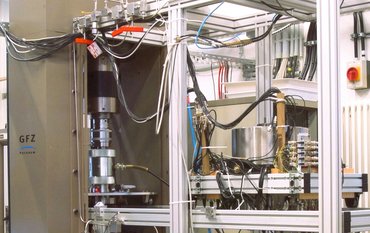42 kilometres: This is the average thickness of the Earth's continental crust, but why is that so? What does this mean for plate tectonics? Researchers have new evidence that a stable thermodynamic equilibrium prevails at this thickness.
Stable conditions? There are almost none on Earth. Everything is dynamic, in motion and changing. And yet there is stability in the dynamics: researchers from GFZ Section 4.5 “Basin Modelling” of the German Research Centre for Geosciences GFZ have found evidence that a stable thermodynamic equilibrium exists between the internal energy of the Earth's lithospheric plates and the tectonic plate boundary forces when the thickness of the continental crust reaches around 42 kilometres. For their study, the scientists used data on the thickness, age and chemical composition of the Earth's crust and upper mantle as a basis for calculating thermomechanical models describing the stability of the continental lithosphere in the Alpine-Himalayan Collision Zone (AHCZ). The results have been published in Scientific Reports 13. The main author of the study is Ajay Kumar, also involved were Mauro Cacace and Magdalena Scheck-Wenderoth, Head of GFZ Section 4.5 and Director of the GFZ Department Geosystems.
The deformation of continents is controlled by the interplay of tectonic and gravitational forces. This interaction changes depending on the thickness and strength of the lithosphere, which in turn is controlled by temperature. Therebye deviations from a thermal equilibrium and the re-establishment of the latter (thermal relaxation) are of key importance. As a result, the interplay can either lead to the stabilization towards a state of equilibrium for this critical crustal thickness or an increased disequilibrium for value larger or smaller than the critical crustal thickness resulting in deformation of the lithosphereic plate.
In order to identify and prove this specific Earth crustal thickness, the scientists in GFZ Section 4.5 have taken a very close look at the large plate collision zone that stretches from the Alps to the Himalayas (AHCZ│Alpine-Himalayan Collision Zone). The AHCZ is the result of the closure of the Palaeo-Tethys Ocean between the southern edge of Eurasia and the northern edge of the Gondwana palaeocontinent and subsequent collison of the two continents. The collision zone comprises continental lithosphere of different tectonothermal ages. Using data-supported thermomechanical modelling of the collision zone, the researchers were able to show why deviations from this equilibrium thickness of the continental crust lead to continental deformation. In particular along those parts of the AHCZ where the continental crust is severely thickened this leads to a diffuse distribution of deformation and related seismicity.
The decisive factor here is radiogenic heat, i.e. the heat produced by the crust when radioactive elements decay. If the continental crust is thicker than 42 kilometres, the additional radiogenic heat causes the internal energy to increase and be dissipated in the form of diffuse deformation. Under Tibet, for example, a tectonically very active zone, the earth's crust reaches a thickness of up to approx. 80 km. In many tectonically active orogens of the earth, the earth's crust is thicker than 42 kilometres. These differences in thickness explain why seismicity in the area of the AHCZ collision zone is widely and diffusely distributed, which is in contrast to the localised deformations occuring along the plate boundaries. In a collision zone that leads to the folding of mountains, such as in Nepal, earthquakes are widely distributed over the entire orogen. At the plate boundaries on the other hand, earthquakes occur quite precisely along the plate boundary such as along the subduction zone in Indonesia or Chile, where plates slide over or under each other, or the transform fault as along the San Andreas Fault.
The continental crustal thickness of 42 km found in this study corresponds approximately to the global average of today's continental crust on Earth and is also typical of stable old cratons. These are the oldest core areas of the continents, which mostly consist of crystalline rocks.
The dissipative*, thermodynamic feedback between thermal relaxation of the increased internal energy and the mechanical relaxation leads to an equilibrium being established. The results of the study also indicate a genetic connection between the thermo-chemical state of the Earth's crust and the tectonic development of silicate Earth-like celestial bodies (Mercury, Venus, Moon, Mars). Roughly three phases emerge: (1) a phase of very high internal energy that is too hot for plates to form, (2) a phase of plate-tectonics during which the forces in response to the internal energy and the plate boundary forces are balanced and (3) a phase of a stagnant lid when the internal energy is smaller than the plate boundary forces and the increased strength of the lithospheric plates prevents plate deformation.
*Dissipative processes irreversibly convert energy into heat.
Original study:
Kumar, A., Cacace, M. & Scheck-Wenderoth, M. Thermodynamics of continental deformation. Sci Rep 13, 19920 (2023). https://doi.org/10.1038/s41598-023-47054-3 / https://www.nature.com/articles/s41598-023-47054-3
Captions:
Fig.:
a) Map: Variation of long-term crustal strength in the area of the collision zone, which extends from the Alps to the Himalayas (AHCZ), and distribution of seismicity from the ISC-GEM catalogue (Storchak et al. 2013). The seismicity is colour-coded according to depth and magnitude. The kinematic plate boundaries from Bird (2003) are shown as green curves. In the continental regions, darker shades of brown indicate thicker and weaker crust corresponding to the mountains/orogens. Lighter shades of brown indicate a thicker crust in the stable continental interior.
b) Plot of crustal strength in relation to crustal thickness (data points from Crust 1.0, Laske et al. 2013), which shows a positive correlation for crustal thicknesses up to ~42 km and a negative correlation for thicknesses greater than 42 km. The coloured circles show the topography associated with the data points and are scaled in size based on the upper crustal thickness. White circles show a scenario in which no radiogenic heat production in the crust is considered, demonstrating that crustal strength would continuously increase with thickness if internal heat production was eliminated.











![[Translate to English:] Torsten Sachs in front of a climate station on a field](/fileadmin/_processed_/3/9/csm__TorstenSachs_bearbeitet_GS_4a1365ef84.jpeg)

![[Translate to English:] left image flood at the Ahrtal: image from above, several houses are flooded; left image:: Heidi Kreibich;](/fileadmin/_processed_/4/4/csm_Bild2_9af0130e9f.png)


![[Translate to English:] Start der Vega Rakete](/fileadmin/_processed_/6/4/csm_20231201-kachel_Vega-VV23-launch_ESA-CNES-Arianespace_706716b68c.jpeg)









![[Translate to English:] Poster exhibition at the Brandenburg Hydrogen Day at the GFZ, some participants in the foreground](/fileadmin/_processed_/6/5/csm_Erster_Brandenburgischer_Wasserstofftag_GFZ_402fcec95e.jpeg)
![[Translate to English:] Group picture of the participants](/fileadmin/_processed_/9/4/csm_20231108_CAWa-Workshop-Tashkent_Gruppenbild_99ea779d8a.jpeg)

![[Translate to English:] [Translate to English:] Hörsaal](/fileadmin/_processed_/e/6/csm_H%C3%B6rsal_e21ac645fb.jpeg)


![[Translate to English:] The Delegations in the Historic Library on the Telegrafenberg. In the back there are from left to right, the Dutch Ambassador for Germany, Ronald van Roeden, the Dutch Minister for Education, Culture and Science, Robbert Dijkgraaf and the scientific director of the GFZ, Susanne Buiter.](/fileadmin/_processed_/d/b/csm_Kachel-2_9eba4b4212.jpeg)


